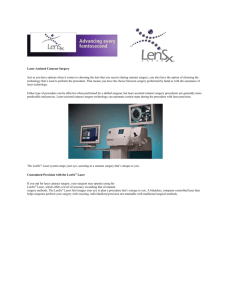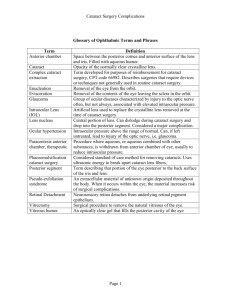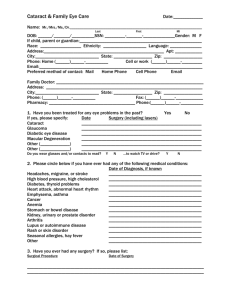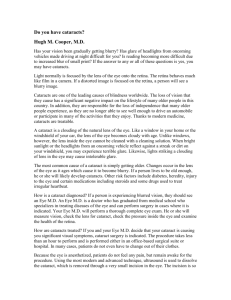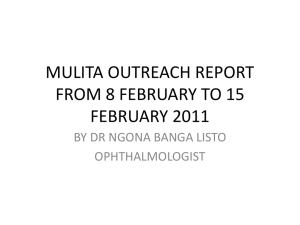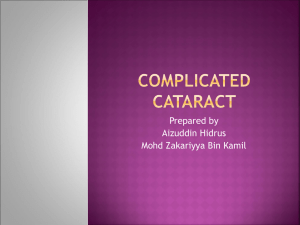Read Frequently Asked Questions About The FEMTO LDV Z8
advertisement
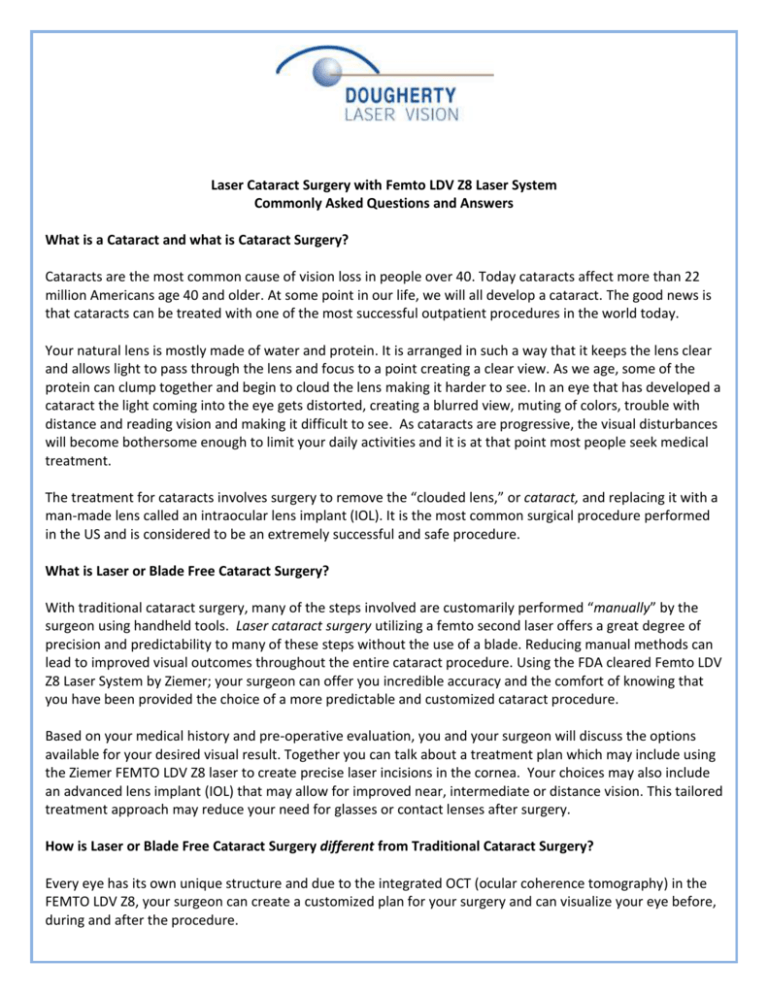
Laser Cataract Surgery with Femto LDV Z8 Laser System Commonly Asked Questions and Answers What is a Cataract and what is Cataract Surgery? Cataracts are the most common cause of vision loss in people over 40. Today cataracts affect more than 22 million Americans age 40 and older. At some point in our life, we will all develop a cataract. The good news is that cataracts can be treated with one of the most successful outpatient procedures in the world today. Your natural lens is mostly made of water and protein. It is arranged in such a way that it keeps the lens clear and allows light to pass through the lens and focus to a point creating a clear view. As we age, some of the protein can clump together and begin to cloud the lens making it harder to see. In an eye that has developed a cataract the light coming into the eye gets distorted, creating a blurred view, muting of colors, trouble with distance and reading vision and making it difficult to see. As cataracts are progressive, the visual disturbances will become bothersome enough to limit your daily activities and it is at that point most people seek medical treatment. The treatment for cataracts involves surgery to remove the “clouded lens,” or cataract, and replacing it with a man-made lens called an intraocular lens implant (IOL). It is the most common surgical procedure performed in the US and is considered to be an extremely successful and safe procedure. What is Laser or Blade Free Cataract Surgery? With traditional cataract surgery, many of the steps involved are customarily performed “manually” by the surgeon using handheld tools. Laser cataract surgery utilizing a femto second laser offers a great degree of precision and predictability to many of these steps without the use of a blade. Reducing manual methods can lead to improved visual outcomes throughout the entire cataract procedure. Using the FDA cleared Femto LDV Z8 Laser System by Ziemer; your surgeon can offer you incredible accuracy and the comfort of knowing that you have been provided the choice of a more predictable and customized cataract procedure. Based on your medical history and pre-operative evaluation, you and your surgeon will discuss the options available for your desired visual result. Together you can talk about a treatment plan which may include using the Ziemer FEMTO LDV Z8 laser to create precise laser incisions in the cornea. Your choices may also include an advanced lens implant (IOL) that may allow for improved near, intermediate or distance vision. This tailored treatment approach may reduce your need for glasses or contact lenses after surgery. How is Laser or Blade Free Cataract Surgery different from Traditional Cataract Surgery? Every eye has its own unique structure and due to the integrated OCT (ocular coherence tomography) in the FEMTO LDV Z8, your surgeon can create a customized plan for your surgery and can visualize your eye before, during and after the procedure. To start the surgery, without making an incision in the eye, laser energy is delivered through the cornea to soften the clouded lens which makes it easier to remove. Next, the laser continues to deliver energy through the cornea to make a perfectly round and well-cantered opening in the anterior covering of the clouded lens (the lens capsule) to allow access to remove the central clouded part of the lens from within the lens capsule.In traditional cataract surgery, incisions in the cornea also referred to as the “watch glass,” or front of the eye, are made using handheld instruments including blades to access the cataract. Your surgeon will then use a surgical device to manually create an opening in the lens capsule of the eye that holds the cataract. The goal in these steps is to make the corneal incisions precise and the opening in the lens capsule as circular as possible, positioned properly, and sized to fit the replacement lens. Consider drawing a circle free hand ten times in a row as perfectly as possible. With experience you can do your best to replicate that circle, but each try will never be exactly the same. Now apply this analogy to the cataract procedure. A laser increases the opportunity of making and positioning the corneal incision with more predictability and accuracy. The FEMTO LDV Z8 platform gives your surgeon the ability to create these same corneal incisions blade free, with a high degree of precision that cannot be reproduced manually despite choosing a highly experienced surgeon. The laser assisted Corneal Incisions can be done using only topical anesthetics and offers quick healing with no need for stitches and fast visual recovery. What are the benefits of laser or blade free cataract surgery? A highly customized treatment A treatment with little or no discomfort A precise and predictable treatment A gentler and easier cataract removal Generally, a more rapid visual recovery due to reduced inflammation The opportunity to receive tailored treatment with advanced intraocular lens technology which may reduce the need for glasses or contacts after surgery Am I a suitable candidate for laser or blade free cataract surgery? Your elected surgeon will discuss with you on a “one to one” basis your suitability for the laser cataract procedure. If you are interested in having a predictable and precise incision and the possibility of a better visual outcome, ask your doctor to discuss your options with you. How long has the procedure been performed? Thousands of cataract procedures have been successfully performed using Femtosecond Laser systems. Femtosecond lasers have been commonly used for LASIK procedures to rid patients of their dependence on glasses or contacts for many years in the United States since its FDA approval in 2001. Femtosecond lasers represent an advanced standard in precision laser cataract surgery with the Ziemer FEMTO LDV Z8 platform being FDA approved in 2015. What should I expect on the day of surgery? Cataract surgery is an outpatient procedure and your entire stay at the ambulatory surgical center is usually two to three hours. Make sure that you have followed all of your pre-operative instructions from your physician and plan to have a family member escort you. You will meet with a pre-operative nurse who will review with you all the events that will happen during your time at the center and you will receive medication to calm you as well as several eye drops. The procedure usually takes between 15 and 30 minutes and then you will spend some time in recovery room where you will have you eye patched for protection and then sent home with eye drops to use. What should I expect after surgery? After surgery your eyes may be watery and feel a little gritty. The discomfort is usually minimal, typically handled with a mild pain reliever. You will go home with several eye drops to use to prevent infection and inflammation and your eye will be covered with a clear patch for protection. If you notice a significant change or decrease in vision or significant pain you should contact your physician. How does the laser work? What is it doing to my eye? Your eye has its own unique characteristics in size and shape. This process enables your surgeon to create a highly customized treatment plan that is tailored for your eye. The laser then focuses light to create precise incisions exactly where intended. The laser makes the incisions in a matter of seconds. You should experience little, if any, discomfort. What will I feel? The actual treatment is painless. The only discomfort that may be experienced during the procedure is a light pressure sensation around your eye from the various instruments that are used. After the procedure your eyes may feel gritty and watery for several hours. How long does the procedure take? You can expect to be at our center for 2 to 3 hours. And you will be in the procedure room for 15 - 20 minutes. What should I expect for recovery? During the first day you might feel mild discomfort. The eye may be watery and feel a little gritty. You will be given several eye drops to use after surgery and vision will improve daily. Several post-operative visits will be scheduled with your physician in the first two weeks so that your progress can be monitored. Most patients feel comfortable returning to work within the first two to three days, but you can determine this with your doctor during the post-op visits. Note: Visual recovery may be more rapid because of reduced energy and inflammation.

